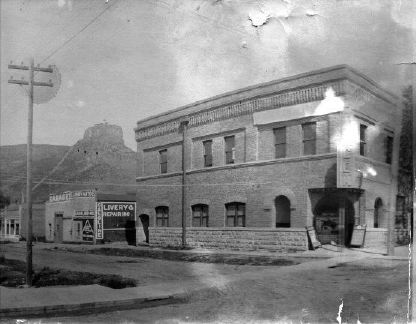
Gem Theatre – c.1915
Photo courtesy Ryland Collection, Gardner Family Collection
James H. Gow, the locally-educated master who had designed Golden’s Methodist and Presbyterian churches, was hired by Seig to design the new building to house the Gem. As usual, Gow did not disappoint in coming up with an interesting design. Built of brick atop a high Morrison sandstone veneer foundation, the building featured a lower floor of segmental arched windows and an upper floor of flat-topped windows arranged largely in pairs across the facade. Projecting brickwork of cornices and pilasters abounded. A central entrance with an enclosed grand arch on the west wall on the Avenue led into the new Gem Theatre, where 300 seats sat angled towards the screen at the northeast corner of the decorative motif auditorium.
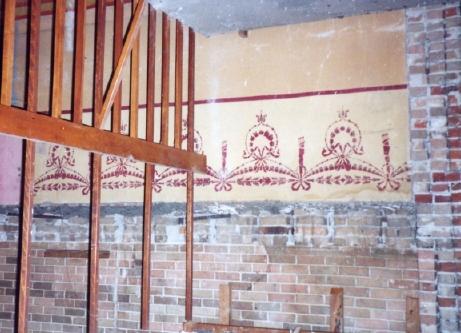
Earliest motif of the Gem Theatre
Photo courtesy Gardner Family Collection
The tiny Golden Tailor Shop adjoined the lobby in the southern front. On the north side, a doorway at the far eastern end of the building led to the Golden Athletic Club upstairs. The Athletic Club’s quarters were impressive, featuring a maple wood gymnasium floor with cloak, locker and shower rooms, and a balcony seating over 150 overlooking it all. The building took awhile to build, the east wall being particularly troublesome, but it was finally completed, and the Gem showed its first picture there on June 1, 1912. Quickly the proprietors added “a couple of clean Vaudeville acts” on Wednesday evenings. The Athletic Club moved in on June 11, and patrons were serenaded by their new Nicholls Bros. piano and Lohmann’s orchestra.
Despite such a promising start, the Golden Athletic Club went out of existence in January 1913, leaving the Gem alone as the building’s primary occupant. Over time the upper floor came to be called Seig Hall and was rented out for various temporary uses including the local Republican party headquarters, while the tailor shop’s spot became a small cafe for the theater. Meanwhile, the Gem did such a flourishing business that its entrance was quickly changed to a cutoff corner rounded arch. In a planned 1916 renovation by Gow, the Gem was to eliminate the restaurant, put in a new ticket booth and ladies cloak room and restroom, and switch the screen to the center of the east wall. However, aside from the screen nothing appears to have been changed from the original, outside of eliminating the central metal support posts late in 1912. 1916 plans also called for expansion into Seig Hall, but this would have to wait for the future. In the meantime, the Gem battled competition from the Star Theatre, which resurrected itself in the Belle Vista after the Gem left, attracting noteworthy movies and acts. However, around 1913 it finally gave up the ghost, leaving the Gem alone in the field. In 1921 Oscar Goetze and his wife opened Golden’s fourth movie theater, the Pixie, inside the Odd Fellows Hall at 1106 Washington Avenue. Lasting into 1922, it was not as state-of-the-art as the Gem but it sure gave it lively competition.
By 1926 longtime partner M.W. McFarland had acquired all of the Gem and its building. Immediately he resolved to make it one of the finest showhouses around, starting with installing a new theater organ to accompany the films. It was a Photoplayer, described well by the Transcript. This fabulous instrument “consists of pipe and traps for the following effects: Treble, vox mystica, cornet, flute, flute d’Ahour, viol d’orchastra, bass ciol d’orchestra, violincello, quintoton, reed organ and pipes 65-note range, set of orchestra bells, xylophone, bass drum, pistol shots, double cymbal, tom-tom, thunder, snare drum, bird whistle, chinese wood drum, triangle, fire gong, cathedral chimes, tambourine, castanets, horses hoofs, klaxon, sleigh bells, chinese crash cymbal, steamboat whistle, wind siren, locomotive exhaust, automobile exhaust.” The Photoplayer was the perfect companion for silent films. McFarland resolved to go much further and fulfill the previous renovation plans, hiring architect Herbert Tracy Quick and contractor Charles J. Buckman to transform the upper floor into a new 12-row 250-seat balcony, build a handsome new modernistic marquee, return the entrance to the center of the Avenue facade, and take out the lower floor east wall to build a new popout alcove stage. These renovations expanded the theater’s capacity and enhanced its live entertainment. Soon renovations were underway in 1926.

From the front page of the Colorado Transcript, 1926
Disaster struck on July 23, 1926. While workers were engaged in punching holes in the east wall of the theater, a huge portion of it fell, taking carpenter D.D. Branch down with it from atop a scaffold 17 feet high. The other workers, who had just left the scaffolding only minutes before, rushed to his aid, extricating him from the bricks that had buried him. Branch was rushed to a Denver hospital with a skull fracture and severe lacerations, but in time, he would recover. Townsfolk recalled how the wall had been built with difficulty 15 years before and that rumors had persisted since then that the wall was unsafe. Unwilling to risk anything further, McFarland ordered the entire wall destroyed and replaced like new.

Golden Gem Theatre, 1932
From advertisement in the Colorado School of Mines Prospector Yearbook, 1932
The Gem reopened on September 25. It was a neat new little movie palace, featuring new decoration in day-glo Art Deco motif, fitting in well with the style of its times.
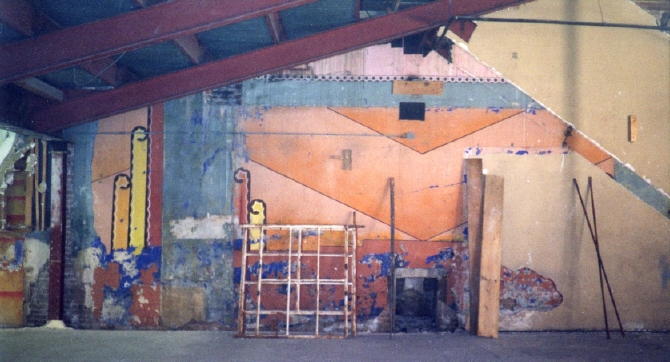
Day glo deco theater walls
Photo courtesy Gardner Family Collection
Its premiere movie was “The Strong Man” starring Harry Langdon. By the time all was said and done, McFarland had spent $40,000 on the Gem since taking fully over earlier that year.
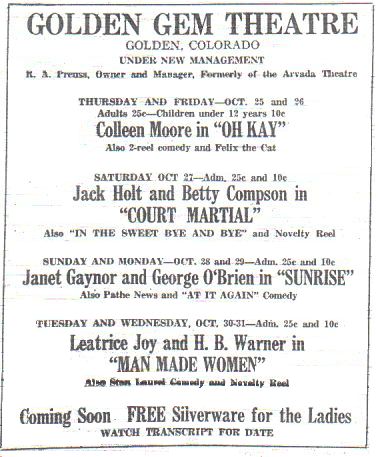
1st advertisement of the Golden Gem Theatre, Colorado Transcript 1928
The fine movie palace attracted attention, and not just for the films of local Hollywood western star Pete Morrison that it showed. In 1928 Richard A. Preuss bought the theater. Preuss had recently been the proprietor of the Arvada Theatre, and he renamed the venue in Golden the Golden Gem Theatre. From there onward it was primarily a movie house, with popular organist Rose Schmidt accompanying the films. In 1929 talkie films were introduced at the Golden Gem, starting with “The Donovan Affair”. Preuss pressed forward with continued success, facing the challenge of the Great Depression by giving away groceries to needy people and letting his theater be a stabilizing economic force for downtown as well as a chance for people to escape their grim reality. But soon Preuss wished to retreat to a more relaxing life.
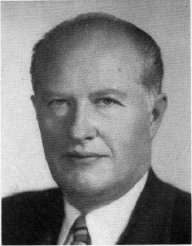
Charles U. Yeager, President of the Atlas Theatre Company
Photo courtesy Gardner Family Collection
In 1935 Preuss leased the Golden Gem to the Denver-based Atlas Theatre Company chain led by Charles U. Yeager. This prosperous chain possessed a number of popular movie houses, including the Oriental, Gothic, Federal, Holiday and Ritz. Atlas brought prosperity, a stunning new neon gemstone marquee, and quality first-run films to the Golden Gem, and as the theater industry evolved towards larger and grander movie palaces, Atlas wanted to take Golden’s theater along with it.

Golden Gem Theatre, c. 1935
Photo courtesy Golden Transcript, 1978
In 1948 the historic stone Wells Fargo stable next door to the east was purchased and destroyed, to make way for a grand new renovation that started with doubling the theater’s size. Yeager sought to take the theater to a whole new level of moviegoing experience: the Theatre Beautiful.
